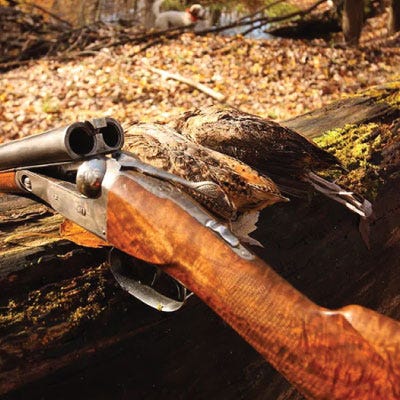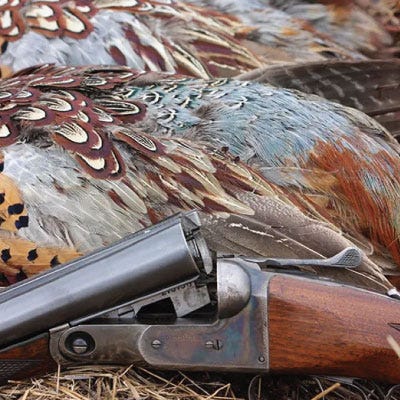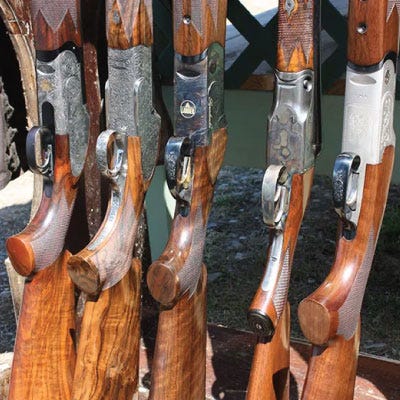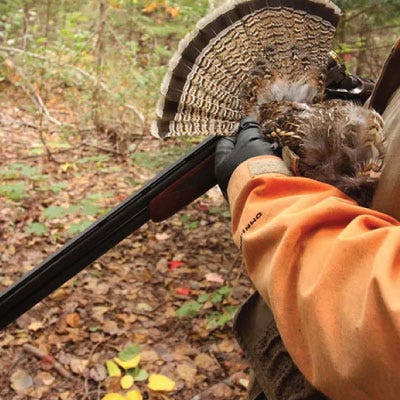What You Need to Know About Side-by-Side versus Over/Under Shotguns

Some topics are worth chewing on in the same way a dog worries a bone. And when it comes to the great break-action shotgun debate, that being the side-by-side versus the over/under, watch for some sparks to fly. It's been a cage match for a long time with each camp having its own fanbase. Just remember that the word 'fan' comes from fanatical...
Side-by-side fans are quick to say that their choices are Heavenly ordained. "If the Lord wanted folks to shoot an over/under then He’d have arranged the eyes in our heads differently.” Over/under devotees say, "If you want to hit your target then get an over/under." Side-bys are considered traditional shotguns, the kind your daddy used when shooting game. Over/unders, which are used in all major competitions including the Olympics, can be tricked out sporting machines. There are a lot of points between, so let's look at a few more compelling reasons to own one or the other or, possibly, both.


Sight Plane
Side-by-side proponents quickly say the horizontal shooting plane affords them unparalleled target acquisition. That view facilitates an even swing. A better technique is required when shooting a side-by-side to train a gunner to avoid lifting his head from the stock to peak over their barrels. Gun fit for side-bys is more critical than for an over/under. These days, many side-by fans restock classic guns made in the early 1900s for those shotguns that have too much drop at comb and heel which causes the shooter to see the release lever instead of looking down the rib. Proper fit is important with a side-by-side particularly if it’s from a vintage era.
Over/under shooters have an easier time with the single sight plane and believe one line naturally leads the shooter's eye from the stock toward the target. Concentration on the target is key, and the stacked nature of an over/unders' barrels obscures the view less. Some shooters feel the vertical sight plane of an over/under causes the rib to disappear in certain shooting conditions like those specialized snap shooting techniques used for Ruffed grouse or woodcock woods. That theory supports why over/unders seem to be more popular on clays courses, on waterfowl, and in field-shooting conditions or pheasant or prairie birds.
With all of that said and done, the real issue is a personal preference of how each shooter wants to see the world. And while some gunners switch back and forth from the horizontal view offered by a side-by-side to the single, vertical-sight plane of an over/under, it's more common for shooters to stick to one or the other.


Double Triggers vs. Single Triggers
One major reason bird hunters prefer side-bys are because of their double triggers. The two triggers allow for immediate barrel selection as the front trigger discharges the right barrel and the rear trigger fires the left barrel. Chokes are traditionally fixed in a side-by, and they are looser in the right barrel and tighter in the left barrel. After acquiring, the target gunners can easily slide their finger to choose the shot appropriate to the flush. There is no hesitation, no fumbling when wearing gloves, just an immediate call-to-action.
Ready for Opening Day? Read about what Opening Day for duck is like in the Pacific Northwest.
Over/unders typically feature a single trigger which is typically combined with the safety. The single selective trigger on an over/under is one of the more complicated patterns in gun design as it’s required to allow the shooter the choice between top or bottom barrel as well as work as a safety while allowing the hammers to reset after the first shot. Because of all the moving parts, many selective safeties are prone to mechanical issues. Sometimes both barrels fire simultaneously and the flipping the selector switch can be cumbersome, particularly when wearing gloves.
The side-by-side two-trigger/one safety design allows for the gun’s structure and function to be independent of each other, thereby allowing for simplicity, speed, and safety to rule the day. Perhaps the two triggers and safety are the main reason why side-by-sides are considered game guns while the over/under is viewed more as a clay or waterfowl gun.


Stock
On the stock side, most side-by-sides come with a splinter forend and either a modified pistol grip or a straight English stock. Hands gripping the slender forend oftentimes wrap around the barrels thereby cluttering the view. The sleekness and lighter weight that accompanies a splinter forend adds to the grace of a side-by-side. A splinter forend combined with a straight English stock provides exceptional balance and pointability which are two primary areas of interest for bird hunters. Some of the older American side-by-sides had more drop-at-heel than English or contemporary shotguns; ensuring that the gun shoots where you’re looking is critical for any type of bird hunting. Proper fit is important too.
Modern over/unders have beavertail forends that offer the lead hand something substantive to grip. A full pistol grip provides an angle that offers a more natural and relaxed grip. More modern over/unders feature standard dimensions of 14 1/2 LOP and 1 1/2 DAC and 2 1/2 DAH, which are common dimensions for American shooters.


Recoil
Recoil comes from the barrel and stock design along with weight. Barrels of a side-by sit higher up while the stacked nature of an over/under positions them deeper into the stock. The O/U's first barrel recoil is low in the shoulder and produces less barrel flip than a side-by. Second shots can be more accurate, which is why clay target competitions are won by over/under shooters.
Recoil is also affected by a shotgun's weight. Side-by-side game guns were typically designed around the plus/minus 6.5-pound weight, so they'd be lighter to carry. Over/unders and their beefier semi-pistol grips, raised ribs, and longer chambers are heavier. More weight, less recoil, carry the side-by on game and you'll prefer the lighter recoil on the clays course and in the duck blind.
No matter your side of the debate, we are here to help. Shop our selection of all shotguns.
When you think about it, shotgun design hasn’t really changed much at all in the past century and a half. Some of the tooling and the materials are very different, but the geometry of the actions are very similar. What has changed is the way in which fit and instruction are performed. Match your fit with the correct choke and shells and you'll be as efficient with a side-by-side as with an over/under.

